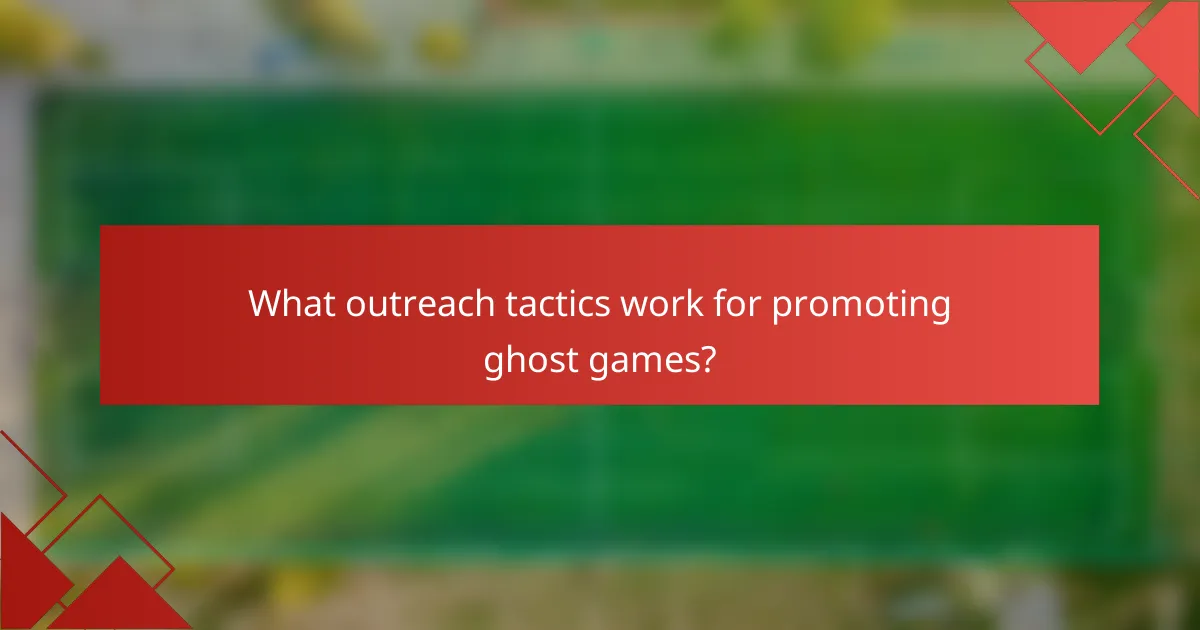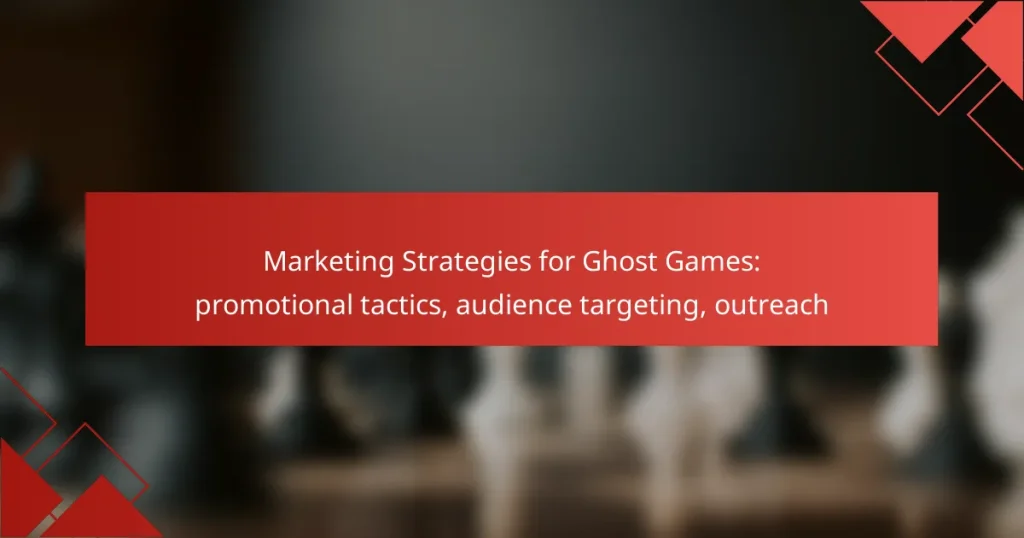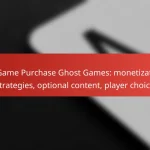Marketing strategies for ghost games require a multifaceted approach that includes targeted social media advertising, influencer collaborations, and engaging content marketing. By understanding the demographics and interests of potential players, marketers can effectively reach and resonate with their audience. Additionally, community engagement and participation in relevant events can significantly enhance visibility and foster a loyal fan base.

What marketing strategies are effective for ghost games in the US?
Effective marketing strategies for ghost games in the US include targeted social media advertising, influencer partnerships, content marketing, email campaigns, and in-game promotions. These tactics help reach the right audience and engage them in unique ways that resonate with their interests in the genre.
Social media advertising
Social media advertising is crucial for promoting ghost games, as platforms like Facebook, Instagram, and TikTok allow for targeted ads based on user interests and behaviors. Consider using eye-catching visuals and short video clips that highlight key game features or thrilling moments to attract attention.
Utilize A/B testing to optimize ad performance, adjusting elements such as images, copy, and calls to action based on engagement metrics. Allocate a budget that allows for flexibility, starting with a few hundred dollars and scaling based on successful campaigns.
Influencer partnerships
Partnering with influencers who specialize in gaming can significantly boost visibility for ghost games. Look for influencers with a dedicated following in the horror or supernatural genres, as their audience is likely to be interested in your game.
Negotiate terms that align with your budget, whether through monetary compensation or game giveaways. Ensure that the influencer’s style matches your brand’s tone to create authentic content that resonates with potential players.
Content marketing
Content marketing involves creating engaging articles, videos, or podcasts that explore themes related to ghost games. This could include behind-the-scenes development stories, gameplay tips, or discussions about ghost lore, which can attract and retain an audience.
Consider maintaining a blog or a YouTube channel dedicated to your game, providing regular updates and insights. This not only builds community but also improves search engine visibility, drawing in organic traffic over time.
Email campaigns
Email campaigns can effectively keep your audience informed and engaged with your ghost game. Build a mailing list through your website or social media, offering incentives like exclusive content or early access to updates.
Craft compelling newsletters that include game news, special promotions, and personalized content to maintain interest. Segment your audience based on their engagement levels to tailor messages that resonate with different groups.
In-game promotions
In-game promotions can enhance player engagement and drive sales. Consider offering limited-time events, exclusive items, or discounts that encourage players to participate and share their experiences on social media.
Utilize analytics to track the effectiveness of these promotions, adjusting strategies based on player feedback and participation rates. This approach not only boosts current engagement but can also attract new players through word-of-mouth.

How to target audiences for ghost games?
Targeting audiences for ghost games involves identifying specific groups likely to engage with this genre. Effective strategies include analyzing demographics, understanding behavioral patterns, and focusing on interests that align with ghost-themed content.
Demographic analysis
Demographic analysis helps pinpoint the age, gender, income level, and location of potential players. For ghost games, younger audiences, particularly those aged 18 to 34, often show higher engagement due to their affinity for horror and supernatural themes.
Consider using surveys or social media insights to gather data on your audience’s demographics. Tailoring marketing messages to resonate with specific age groups or genders can significantly enhance outreach effectiveness.
Behavioral segmentation
Behavioral segmentation focuses on how potential players interact with games, including their gaming habits, spending patterns, and engagement levels. For ghost games, identifying players who frequently enjoy horror titles or participate in online gaming communities can be beneficial.
Utilize analytics tools to track user behavior on gaming platforms. This data can inform targeted promotions, such as special offers for players who have previously purchased similar games or engaged with ghost-themed content.
Interest-based targeting
Interest-based targeting involves reaching out to audiences based on their hobbies and preferences. For ghost games, this could include targeting fans of horror movies, paranormal podcasts, or supernatural literature.
Leverage social media advertising to create campaigns that appeal to these interests. Collaborating with influencers in the horror genre can also amplify your reach and attract a dedicated audience interested in ghost games.

What outreach tactics work for promoting ghost games?
Effective outreach tactics for promoting ghost games include community engagement, event sponsorship, and participation in online forums and groups. These strategies help build a dedicated audience and enhance visibility in the gaming market.
Community engagement
Community engagement involves actively participating in conversations and activities within gaming communities. This can be achieved through social media platforms, gaming conventions, and local meetups. Engaging with fans and players fosters loyalty and encourages word-of-mouth promotion.
Consider hosting Q&A sessions, live streams, or interactive polls to involve your audience. Regular updates and sneak peeks of upcoming features can keep the community excited and invested in your game.
Event sponsorship
Sponsoring gaming events or tournaments is a powerful way to reach a targeted audience. By aligning your brand with popular events, you can gain exposure to potential players who are already interested in ghost games. Look for local or online events that resonate with your game’s theme.
Ensure your sponsorship includes promotional materials, such as banners or merchandise, to maximize visibility. Collaborating with event organizers for exclusive giveaways or contests can further enhance engagement and attract attention to your game.
Online forums and groups
Participating in online forums and groups dedicated to gaming can significantly boost your outreach efforts. Platforms like Reddit, Discord, and specialized gaming forums provide spaces to share insights, answer questions, and promote your game organically. Focus on contributing valuable content rather than overtly advertising.
Join discussions relevant to ghost games and share your experiences or expertise. This approach helps establish credibility and encourages community members to explore your game. Regularly check these platforms for feedback and trends to adapt your marketing strategies effectively.

What are the key performance indicators for ghost game marketing?
The key performance indicators (KPIs) for ghost game marketing include metrics that help evaluate the effectiveness of promotional tactics, audience targeting, and outreach efforts. Understanding these KPIs allows marketers to optimize their strategies and improve overall performance.
Conversion rates
Conversion rates measure the percentage of users who take a desired action, such as making a purchase or signing up for a newsletter. For ghost games, a good conversion rate typically ranges from 2% to 5%, depending on the quality of the marketing campaign and the target audience.
To improve conversion rates, focus on creating compelling calls to action and optimizing landing pages. A/B testing different elements, such as headlines and images, can also help identify what resonates best with your audience.
Customer acquisition cost
Customer acquisition cost (CAC) refers to the total expense incurred to acquire a new customer, including marketing and advertising costs. For ghost games, CAC can vary widely, but aiming for a range of $20 to $50 per customer is a common benchmark.
To keep CAC manageable, consider using targeted advertising and organic outreach strategies. Monitor your spending closely and adjust your tactics based on which channels yield the best results.
Return on ad spend
Return on ad spend (ROAS) measures the revenue generated for every dollar spent on advertising. A typical ROAS for ghost games might be around 3:1, meaning for every $1 spent, $3 in revenue is generated.
To maximize ROAS, focus on high-performing ad channels and continuously analyze campaign data. Adjust your budgets to allocate more resources to the most effective strategies, ensuring that your advertising efforts yield a profitable return.

What are the prerequisites for effective ghost game marketing?
Effective ghost game marketing requires a clear understanding of the target audience, engaging promotional tactics, and strategic outreach. By identifying the right demographics and utilizing tailored messaging, marketers can significantly enhance their campaigns’ impact.
Promotional tactics
Promotional tactics for ghost games should focus on creating immersive experiences that resonate with potential players. Utilizing social media platforms for teaser trailers, behind-the-scenes content, and interactive posts can generate buzz and excitement. Consider hosting live events or virtual reality experiences to engage audiences directly.
Incorporating user-generated content, such as fan art or gameplay videos, can also enhance community involvement. Offering exclusive in-game items or early access to new features as part of promotional campaigns can incentivize participation and foster loyalty.
Audience targeting
Identifying and understanding the target audience is crucial for successful marketing. Ghost games typically appeal to younger demographics, particularly those interested in horror, mystery, and adventure genres. Conducting surveys or analyzing player behavior can help refine audience profiles.
Utilizing data analytics tools can provide insights into player preferences and engagement patterns. Tailoring marketing messages to reflect the interests and motivations of specific audience segments can lead to higher conversion rates and a more engaged player base.
Outreach
Effective outreach strategies for ghost games should leverage multiple channels to maximize visibility. Collaborating with influencers in the gaming community can help reach wider audiences and build credibility. Consider partnerships with popular streamers or content creators who can showcase gameplay and share their experiences.
Email marketing campaigns targeting existing players with updates, promotions, and personalized content can also enhance outreach efforts. Regularly engaging with the community through forums, social media, and events fosters a sense of belonging and encourages word-of-mouth promotion.


